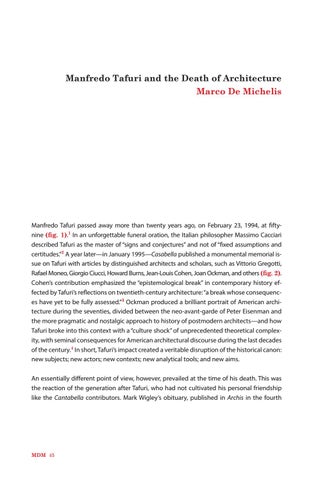Manfredo Tafuri and the Death of Architecture Marco De Michelis
Manfredo Tafuri passed away more than twenty years ago, on February 23, 1994, at fiftynine (fig. 1).1 In an unforgettable funeral oration, the Italian philosopher Massimo Cacciari described Tafuri as the master of “signs and conjectures” and not of “fixed assumptions and certitudes.”2 A year later—in January 1995—Casabella published a monumental memorial issue on Tafuri with articles by distinguished architects and scholars, such as Vittorio Gregotti, Rafael Moneo, Giorgio Ciucci, Howard Burns, Jean-Louis Cohen, Joan Ockman, and others (fig. 2). Cohen’s contribution emphasized the “epistemological break” in contemporary history effected by Tafuri’s reflections on twentieth-century architecture: “a break whose consequences have yet to be fully assessed.”3 Ockman produced a brilliant portrait of American architecture during the seventies, divided between the neo-avant-garde of Peter Eisenman and the more pragmatic and nostalgic approach to history of postmodern architects—and how Tafuri broke into this context with a “culture shock” of unprecedented theoretical complexity, with seminal consequences for American architectural discourse during the last decades of the century.4 In short, Tafuri’s impact created a veritable disruption of the historical canon: new subjects; new actors; new contexts; new analytical tools; and new aims. An essentially different point of view, however, prevailed at the time of his death. This was the reaction of the generation after Tafuri, who had not cultivated his personal friendship like the Cantabella contributors. Mark Wigley’s obituary, published in Archis in the fourth
MDM 45
